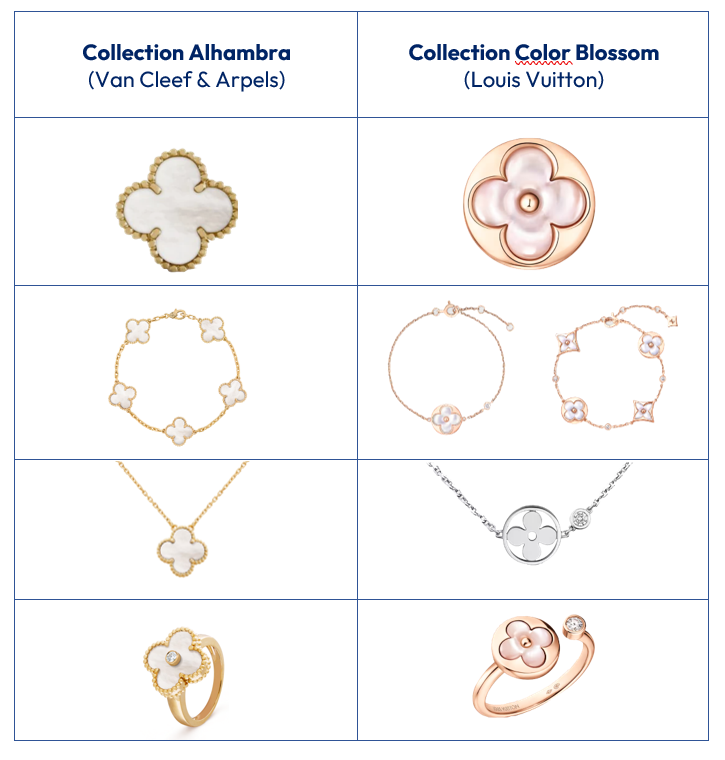The Alhambra clover and the Louis Vuitton flower: mere decorative motifs or exclusive stylistic codes? Beneath the surface lies a fascinating legal debate over parasitic copying in the world of high jewelry—delve into a clash between two luxury giants, at the intersection of creative strategy, iconic tradition and legal arbitration.
But how exactly does this legal mechanism function? What are the conditions and durations of protection? Mastering this strategic framework is essential to optimise your protection.
Judgment No. 203 FS-B of the Court of Cassation, 5 March 2025, Louis Vuitton – Van Cleef & Arpels
1. Context of the Case
Louis Vuitton vs. Van Cleef & Arpels: two hallmark luxury signatures clash over an iconic moti
Since 1968, Maison Van Cleef & Arpels has marketed an Alhambra jewelry line identifiable by a quadrilobed clover motif crafted from semi-precious hardstone, encircled by a beaded or smooth precious-metal frame.
Under the creative direction of Marc Jacobs, Maison Louis Vuitton entered the fine jewelry arena in 2001. By 2006, it introduced a “Monogram” line featuring a quadrilobed flower with a central element encircled by a ring. The motif, rebranded as Color Blossom, evolved in 2015 into jewelry featuring this flower carved in hardstone with a precious-metal outline.
A few examples from current collections, as showcased on their respective websites:

2. The Legal Battle
Analysis of the decisions rendered by the Commercial Court, the Court of Appeal, and the Court of Cassation
Believing that Louis Vuitton’s jewelry line too closely mirrored its stylistic codes, Van Cleef & Arpels—supported by the Richemont group—sent warnings between 2007 and 2015, eventually filing a lawsuit before the Paris Commercial Court for parasitic copying and damages. On 4 October 2021, the court ruled that:
- Van Cleef & Arpels’ jewelry designs represent individualized economic values;
- The appropriation of the quadrilobed clover motif was not coincidental, with noted similarities in size, framing, and communication;
- Louis Vuitton could not justify its use of a quadrilobed motif in jewelry merely by its prior use in leather goods and prêt-à-porter, given the distinct market context.
Louis Vuitton appealed. In its judgment of 23 June 2023, the Paris Court of Appeal overturned the decision, finding instead that:
Although the quadrilobed flower of the Color Blossom jewel appears to match the Van Cleef & Arpels model in dimension, it does not reproduce all defining features of the iconic design: it is neither edged, nor features beading or a double-sided character; the stone is not smooth and includes a central element… Moreover, the quadrilobed form (four identical circular arcs arranged around a center of symmetry) is a known and common element in applied arts, particularly jewelry design; and coloured precious or semi-precious stones set in precious metal are fashion trends.
The Vuitton houses initially drew inspiration from the quadrilobed flower in their iconic canvas, adapting it to contemporary trends. The mere reproduction of this quadrilobed shape—unpierced, made from semi-precious stone, encircled by metal—does not in itself demonstrate an intention by Louis Vuitton to align itself with the complainants’ emblematic model.
Economic parasitism is a form of unfair conduct, constituting a fault under Article 1240 of the French Civil Code. It occurs when an economic operator deliberately positions itself in the wake of another in order to take undue advantage of its efforts, know-how, reputation, or investments.
Parasitism is assessed on the basis of a set of converging factors, considered as a whole, and independently of any risk of confusion.
A claimant alleging acts of parasitism must therefore (i) identify the specific individualized economic value at issue, and (ii) establish that a third party intentionally sought to exploit it.
Since ideas circulate freely, merely taking up and adapting a concept already implemented by a competitor does not, in itself, amount to parasitic copying.
In this case, the judges rejected the claims: :
- The Court of Appeal did not ignore the similarities between the collections, but concluded that Louis Vuitton had no intention of positioning itself in the wake of its competitor;
- Louis Vuitton drew inspiration from the quadrilobed flower of its iconic monogram canvas (in use since 1896) and incorporated colored stones in line with current fashion trends;
- The “Blossom” flower motif does not reproduce all of the defining features of the “Alhambra” model;
- No evidence was provided that Louis Vuitton deliberately sought to imitate the emblematic pieces of the “Alhambra” collection;
- The semi-precious stones in the “Color Blossom” collection are systematically combined with a single type of gold, with certain combinations absent from the “Alhambra” line. Only seven colored stones are common to both collections—choices reflecting market practice and economic constraints;
- The pieces in both collections are typical products in this field;
- Offering several size variations is not unique to Van Cleef & Arpels;
- No break in Louis Vuitton’s communication strategy was established..
3. Comments
Parasitism and luxury jewelry: key lessons and precautions for creators
3.1 To be established, parasitism (or parasitic competition) requires three cumulative conditions:
(i) the existence of an individualized economic value,
(ii) the competitor’s intention to misappropriate it, and
(iii) unfair conduct resulting in an unjustified advantage.
3.2 In this case, although the first condition was satisfied, the judges were not convinced on the latter two. Louis Vuitton successfully demonstrated reliance on its own artistic heritage by reinterpreting and adapting the emblems of its historic and iconic monogram canvas.

The Court also took into account industry-specific considerations, such as:
- the common nature of floral elements in jewelry, consistent with prevailing fashion trends;
- the “natural” diversification of luxury houses (originally in fashion or leather goods) into jewelry, seen as a brand extension enhancing their image, capitalizing on their reputation, and opening new markets;
The general practice of each luxury house to highlight and expand its emblematic symbols and heritage, creating new products based on their iconic codes to reach broader audiences.
3.3 One lesson is that the influence of general market trends should not be overlooked. Inspiration drawn from such trends does not, by itself, constitute parasitism.
In a sector like fashion, where trend effects are intrinsic, it is often difficult to prove a competitor’s intention to ride on another’s coattails or to establish parasitic conduct. This underlines the importance of protecting, throughout the creative process, each distinctive element by securing appropriate rights. Our firm is available to advise and assist you in developing and implementing a comprehensive protection strategy.
May 2025
